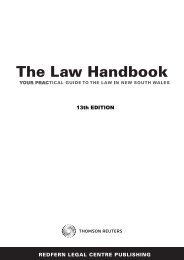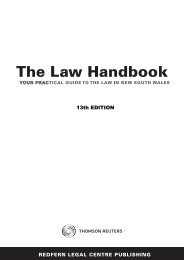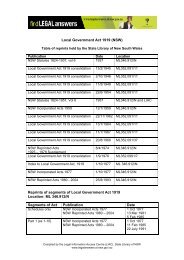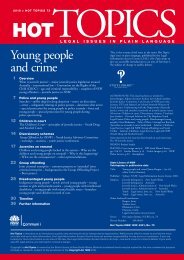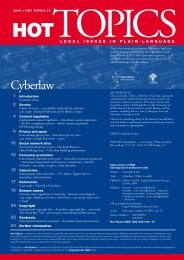Guide to termination and unfair dismissal rights of - Legal ...
Guide to termination and unfair dismissal rights of - Legal ...
Guide to termination and unfair dismissal rights of - Legal ...
- No tags were found...
You also want an ePaper? Increase the reach of your titles
YUMPU automatically turns print PDFs into web optimized ePapers that Google loves.
c)d)the <strong>dismissal</strong> was not consistent with the Small Business Fair Dismissal Code; <strong>and</strong>the <strong>dismissal</strong> was not a case <strong>of</strong> genuine redundancy”.To fully underst<strong>and</strong> this provision it is necessary <strong>to</strong> also underst<strong>and</strong> the meaning <strong>of</strong> the terms used in section 385.The meaning <strong>of</strong> these terms is discussed below.“Dismissed” - An employee must establish that they were dismissed. (Dismissal was discussed in general termsat the beginning <strong>of</strong> this guide.)The FWAct uses the following words: “terminated on the employer’s initiative”. 45 The use <strong>of</strong> these words is wideenough <strong>to</strong> include almost all processes that an employer may begin that result in a <strong>dismissal</strong>.The FWAct goes even further <strong>to</strong> make it clear that employees who were forced <strong>to</strong> resign because <strong>of</strong> the conduc<strong>to</strong>f the employer have also been dismissed under the FWAct. 46 A typical example is where an employer says<strong>to</strong> an employee they will be dismissed if they do not resign. In these circumstances the employee will havebeen dismissed even though they may have formally resigned. There may be other circumstances in which anemployee may be forced <strong>to</strong> resign by the employer. 47An employee will not have been dismissed in any <strong>of</strong> the following situations:•y•y•yThe person was employed for a specified period <strong>of</strong> time, for a specified task or for a specified season<strong>and</strong> employment ended with the conclusion <strong>of</strong> the period, task or season. 48 (These fixed term conceptswere discussed earlier in this guide in relation <strong>to</strong> <strong>termination</strong>).The person was employed under a training arrangement <strong>of</strong> limited duration <strong>and</strong> the <strong>termination</strong> takesplace at the end <strong>of</strong> the training arrangement. 49The person is demoted but the demotion does not involve a significant reduction in remuneration (wages/salary) or duties. 50The definition <strong>of</strong> dismissed contains an anti-avoidance provision. 51 If the employer has employed the person undera fixed term, task specific or seasonal contract for the substantial reason <strong>of</strong> avoiding an employer’s obligationsthen the employee can still make an <strong>unfair</strong> <strong>dismissal</strong> claim.Small Business Fair Dismissal Code – A “small business employer” can defeat an <strong>unfair</strong> <strong>dismissal</strong> claim if theemployer is able <strong>to</strong> establish compliance with the “Small Business Fair Dismissal Code” (the “Code”). 52An employer is a small business employer if less than 15 employees work in the business. 53 Some casualemployees are counted as well as any employee whose employment is being terminated. 54Under the FWAct the responsible Minister <strong>of</strong> the Federal Government has declared the Code <strong>and</strong> its content. 55 Inbrief the Code sets out:•y•y•yCircumstances that permit a summary <strong>dismissal</strong> for serious misconduct.Circumstances in which other <strong>dismissal</strong>s may be made.Various procedures which the employer can follow.If a small business employer can provide evidence <strong>of</strong> compliance with the Code the employer can argue thatthe <strong>dismissal</strong> was not <strong>unfair</strong>. It is important <strong>to</strong> note that an employer cannot defeat an <strong>unfair</strong> <strong>dismissal</strong> claim byjust pointing <strong>to</strong> the existence <strong>and</strong> their knowledge <strong>of</strong> the Code. The employer must provide evidence that theemployer has acted in compliance with (or consistent with) the Code in the actual <strong>dismissal</strong>.The Fair Work Ombudsman has prepared a checklist that some employers may use in following the Code.However, mere use <strong>of</strong> the checklist does not always mean that compliance with the Code has occurred. 56 Anemployer’s argument that the Code has been followed does not prevent an employee from commencing an <strong>unfair</strong><strong>dismissal</strong> claim. It will be up <strong>to</strong> the employer <strong>to</strong> establish that there has been compliance with the Code.10





